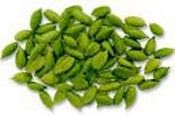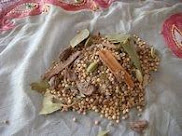Parsi Apricot Chicken - deliciously aromatic, fruity flavours
Hatho Brinjal - flavoursome combination of eggplant, potato, tomatoes, peas and shredded coconut
Recipes from THE NEW CURRY SECRET
Recipes from THE NEW CURRY SECRET
Notes from diary April 2009. It's getting towards the end of April and winter will soon be upon us but right now it is unseasonally warm and unfortunately still quite dry. The rains this year have been a little shy in showing themselves and, as the building of the main house started a little over three weeks ago, it doesn't help that the builders are using lots of water. We are having to buy town water. A big truck brings about 18,000 litres of water at a time and pumps it into what we call the 'cow tank.' This is the tank that provides drinking water for the cattle. Once the house it is built with it's 126,000 litre rain water tank the cow tank will take the overflow from that but for now we have to refill it with purchased water. For the first time we have had to pump water out of this tank into the cottage tank as that has run very low.
The 20,000 litre 'cow' tank
The good thing about the extended summer weather is that we are still picking capsicums, beans and other veg which would normally have finished by by now. It's just as well because my winter veggies are getting off to a slow start. I started them off in seed trays and have been carting them off in card board boxes to Sydney and back so that I can keep them watered. It has not been a successful exercise - I lost some on the journey to Sydney and some on the way back. Second time around I bought some plastic germination boxes with lids so those sowings faired a lot better. Those that I sowed direct into the raised garden beds are getting off to a better start. I've sown just about every variety of winter veg that's available but I'm particularly looking forward to the purple kohl rabi, ruby red sprouts, broad beans and Chinese and Italian broccoli. The brassicas, the family of plants that these veg fall into are particularly prone to the caterpillar of the Cabbage White butterfly which munches its way through the succulent young leaves and totally destroys the plant. I have proof that is true as my emerging kohl rabi plants have been completely eaten and I have been picking green grubs off the Chinese broccoli leaves. I've read that the Cabbage White will only lay its eggs on plants that have not previously been used by other Cabbage Whites for egg laying and you can fool it by scattering pieces of white eggshell around the plants to make it look like others got there first! Mmmm. I'll try that, otherwise I'll have to do a late sowing so that it's past Cabbage White season by the time the leaves emerge.
Growing food has been keeping me busy but I'm also persuing my other love - cooking it. I'm holding my first cooking class for Lesley Russell of the Orange Regional Cooking School soon. I think Parsi Apricot Chicken and Hatho Brinjal will go down well.
Parsi Chicken with Apricots
This delicious Parsi dish has a lovely balance of sweet and sour flavours derived from juicy apricots, soft brown sugar and vinegar. Lamb can be used instead of chicken for a change.
Serves 2-3
450g chicken breast, sliced into bite sized pieces
450ml curry sauce (recipe in The New Curry Secret or use the Quick Version Curry Secret curry sauce)
3 tbs olive oil
1 tsp turmeric
1 tsp salt
2 tsp tomato paste
1 tsp chilli powder
1 tsp paprika
6 dried apricots – quartered
1 tsp soft brown sugar
1 tbsp vinegar
1 tbsp thick cream
1 tsp garam masala
1 tbsp chopped coriander
Cook the chicken first:-
- Heat one tablespoon of oil in a heavy based saucepan and stir in half the turmeric and about 1 tablespoon of the curry sauce. When it starts to bubble, add the chicken pieces stirring well to coat in the oil.
- Sprinkle over half the salt and simmer, stirring now and again for 10-12 minutes until chicken is cooked through.
- Lift the chicken pieces out of the pan with a slotted spoon and set aside until ready to proceed with the recipe.
- Heat the oil in a large, heavy based frying pan and add the tomato puree and turmeric. Stir fry for a minute.
- Add the curry sauce, salt, chilli powder, paprika, apricots, sugar and vinegar. Bring to the boil and simmer for 5 minutes.
- Stir in the chicken and bring back to the boil and simmer, stirring often, for another 5 minutes.
- Stir in the cream and garam masala. Simmer for a minute. Serve sprinkled with coriander.
Hatho Brinjal
Eggplant or aubergine, (known as brinjal in India) is a common and popular vegetable in Indian cooking. It is easy to grow, nutritious and incredibly versatile. It can be fried, roasted, stuffed, mashed, pickled and anything in between!
Good on its own, it also marries well with potatoes and coconut as in this very tasty south Indian dish.
Serves 4 – 6
4 smallish thin eggplant
1 large or 2 small potatoes
4 tbsp olive oil
1 tsp ground cumin
1 tsp ground coriander
2 ripe tomatoes, chopped
1 tsp salt
1 tsp turmeric
2 tbsp grated coconut (or desiccated coconut)
350ml curry sauce (recipe in The New Curry Secret or use the Quick Version Curry Secret curry sauce recipe)
1 tsp chilli powder
100g (3 oz) frozen peas
½ tsp garam masala
1 tbsp chopped coriander
- Slice each eggplant in half and each half into 3 or 4 thick slices depending on the size of the eggplant. Peel the potatoes and cut into slices a little smaller than the eggplant so that they will cook in around the same time.
- Heat the oil in deep, heavy based saucepan, add the cumin and coriander and fry for a few seconds.
- Stir in the tomatoes and salt and cook for 2 – 3 minutes until pulpy and add the turmeric and coconut.
- Stir fry for a minute and add the potato and eggplant.
- Stir on medium heat for about 3 minutes and add the curry sauce and chilli powder. Bring to the boil, cover and simmer for 15-20 minutes, stirring once or twice until the vegetables are tender. Add a little water if the sauce is becoming to dry.
- Remove lid, add the peas and simmer uncovered for a further 5 minutes until most of the liquid has evaporated.
- Stir in the garam masala and simmer for a minute. Serve sprinkled with coriander.














0 comments:
Post a Comment